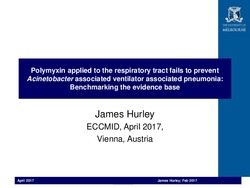Please use this identifier to cite or link to this item:
http://hdl.handle.net/11054/1134| Title: | Polymyxin applied to the respiratory tract fails to prevent Acinetobacter-associated ventilator-associated pneumonia: benchmarking the evidence base. |
| Author: | Hurley, James C. |
| Issue Date: | 2017 |
| Conference Name: | ECCMID 2018: The 27th European Congress of Clinical Microbiology and Infectious Diseases |
| Conference Date: | April 22-25, 2017 |
| Conference Place: | Vienna, Austria |
| Abstract: | Background: Topical polymyxin (PM), in various applications, has been studied as a method for VAP prevention. The effect of topical PM toward preventing Acinetobacter associated VAP (AAVAP) is unknown. The objectives here are to estimate this effect size within randomized controlled trials (RCT’s) and also to reconcile the incidence of AAVAP within the control and intervention groups of these same RCT’s versus an external benchmarked. Material/methods: A meta-analysis and meta-regression using generalized estimating equation (GEE) methods of AAVAP incidence among patients receiving prolonged mechanical ventilation as reported in RCT’s of topical PM based interventions. AAVAP data from 42 studies of a range of interventions other than topical PM (non PM studies) served as additional points of reference. AAVAP benchmarks were derived from 71 observational groups [Ob] without any VAP prevention method under study. Results: The effect size within RCT’s of topical PM on AAVAP is 0.61 (95% confidence interval, CI; 0.4-0.93; n=15). Surprisingly, the mean AAVAP is 4.9% (95% CI 3.0 – 6.8) and 3.7% (95% CI 1.9 - 5.4) for control groups [C] and intervention groups [I] of 20 topical PM studies, respectively, versus 2.7% (95% CI; 2.1-3.4) for the AAVAP benchmark [figure]. In the meta-regression models, membership of the following are significantly correlated with each of VAP and AAVAP; a trauma ICU (positively) and a North American ICU (negatively), whereas for the AAVAP model membership of a topical PM intervention group was not significantly correlated. Conclusions: An unidentified contextual factor confounds the apparent preventative effect of topical PM based interventions with a result that AAVAP incidences within these studies are higher than expected. Other observations implicate cross infection as the basis for this unidentified contextual factor. |
| URI: | http://hdl.handle.net/11054/1134 |
| Internal ID Number: | 01130 |
| Health Subject: | VENTILATOR ASSOCIATED PNEUMONIA CROSS INFECTION BENCHMARKING INCIDENCE ACINETOBACTER POLYMYXINS RESPIRATION, ARTIFICIAL CONTROL GROUPS |
| Type: | Conference Presentation |
| Appears in Collections: | Research Output |
Files in This Item:
| File | Description | Size | Format | |
|---|---|---|---|---|
| jhurley_ESCMID_2017.pdf | 440.97 kB | Adobe PDF |  View/Open |
Items in DSpace are protected by copyright, with all rights reserved, unless otherwise indicated.
